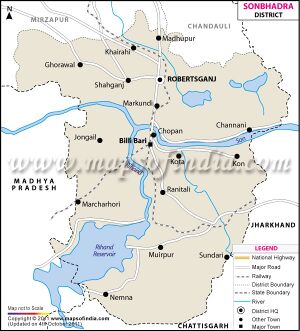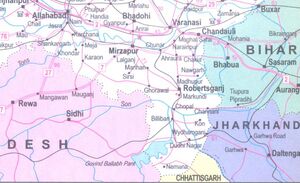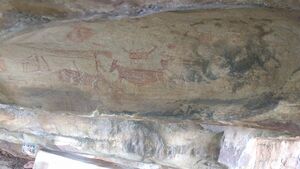Sonbhadra
| Author: Laxman Burdak IFS (R) |


Sonbhadra (सोनभद्र) is the second largest district by area of Uttar Pradesh after Lakhimpur Kheri. The district headquarters is in the town of Robertsganj. Its topology and natural environment prompted First Prime Minister of India Jawaharlal Nehru to refer to Sonbhadra as the "Switzerland of India".[1]
Variants
- Sonebhadra
- Sonanchal
- Sônabhadra/Sonabhadra (सोनभद्र) mentioned in Sarkho Plates of Ratnadeva II - Kalachuri year 880 (1128 AD).[2]
- Gramputra
- Gupt Kashi
- Robertsganj = Sonbhadra City : The city is named after Frederick Roberts, 1st Earl Roberts.
- Sravanabhadra
Location
Sonbhadra lies between Vindhya and Kaimur hills. The district lies in the extreme south-east of the state, and is bounded by Mirzapur district to the northwest, Chandauli district to the north, Kaimur and Rohtas districts of Bihar state to the north-east, Garhwa district of Jharkhand state to the east, Balrampur District of Chhattisgarh state to the south, and Singrauli district of Madhya Pradesh state to the west.
Rivers
The northern part of the district lies on a plateau of the Vindhya Range, and is drained by tributaries of the Ganges including the Belan and Karmanasha rivers. South of the steep escarpment of the Kaimur Range is the valley of the Son River, which flows through the district from west to east. The southern portion of the district is hilly, interspersed with fertile stream valleys. The Rihand River, which rises to the south in the highlands of Surguja district of Chhattisgarh, flows north to join the Son River in the center of the district. The Govind Ballabh Pant Sagar, a reservoir on the Rihand, lies partly in the district and partly in Madhya Pradesh. East of the Rihand, the Kanhar River, which originates in Chhattisgarh, flows north to join the Son River.
History
The district has historic, cultural, and ecological affinities with the Bagelkhand region. Robertsganj is the district headquarters.
The Valley of Son and Belan Rivers abounds in caves which were the earliest dwellings of the primeval inhabitants. This area had been the centre of activities of pre-historic man which is evident from the rock paintings (pre-historic cave art) found in abundance in this region. These paintings are of the periods ranging from Mesolithic to Paleolithic ages.[3]

Sonbhadra, whose ancient name was Gramputra or Gupt Kashi, was built by the ancient king Putrak for his queen Paatali.[4] It is said that Bhars had settlements along with Chero, Searis and Kharwar communities in the district up to fifth century there was the rule of Chandel kings on Vijaygarh Fort. This district was famous as second Kashi during 11th to 13th centuries.
In the 9th century B.C., the Brahmadatta dynasty was subdivided by Nagas. Kushan and Nagas also held supremacy over this region before the advent of the Gupta period. After the death of Harshvardhana in the latter half of the 7th century, it remained under the control of the Gurjara-Pratiharas till 1025 before they were driven out by Mahmud of Ghazni. This area was under the administration of various Governors of Mughal emperors. Some of the forts such as Agori Fort were under the control of Madan Shah.
During the 18th century, the district came under the control of the Venvanshi rulers of Singrauli, who built or occupied several fortresses in the district. In the decade after 1775, the British took over administrative control of most of the territory of the Maharajas of Singrauli. The British district of Mirzapur included present-day Mirzapur and Sonbhadra districts, with all of Patrika. "Foundation day of Sonbhadra History".-day Sonbhadra district included in Robertsganj tehsil. On 4 March 1989, Sonbhadra district was divided from Mirzapur district.[5]
The forts located in the district
The heroine of Famous Novel Chandrakanta written by Devaki Nandan Khatri was the princess of Vijaygarh and the daughter of king Jay Singh.
History of kingdoms in the region
Agori Barhar was an impartible estate. It originally comprised parts of the present districts of Sonbhadra and part of Mirzapur district. It was divided into two parganas of Agori and Barhar. Chandel Raja Paramardideva of Mahoba, ancestor of the family and contemporary of Raja Prithviraj III of Delhi, who attacked Mahoba as the Raja was the ally of Raja Jaichand of Kannauj, and occupied it for a time. Raja Paramardi Deva fled for his life with his friends and family, and though Mahoba was re-occupied by the Raja with the help of Jaichand of Kannauj, the glory of the capital never returned. During this time one of the sons of Raja Paramardi Deva, called Ashajit, fled eastwards in the turmoil that followed. His sons or grand sons called Barimal and Bharimal, captured Agori from the Kaharwar Raja and made themselves the independent rulers of Agori and Barhar. The elder brother Barimal took the kingdom of Agori and Barhar, and the younger brother Bharimal became the ruler of Bardi state ruled by Chandels.
Another jagirdari in sonbhadra in Vijaygarh. It was also ruled by Chandel Dynasty after that by Narayan dynasty.
All of these erstwhile kingdoms were defeated by the Kingdom of Singrauli in the 9th century by Maharaja Kot Rai Singh and were made as feudatories of the main ruler. The Kingdom extended from Singrauli to Sasaram in Bihar (includes Sonebhadra).
Venvanshi rulers
Benvanshi or Venvanshi ruled several kingdoms (princely states) and feudal zamindaries (estates). The Venvanshi people are the predominant people in southern parts of Uttar Pradesh like Mirzapur, Sonbhadra, parts of Madhya Pradesh like the Baghelkhand region and northern parts of Chhattisgarh and western parts of Bihar. The name is derived from Maharaja Ven of the Singrauli kingdom. The Venvanshis claim descent from Brihadratha Maurya. The theory is that the grandson of the last Mauryan emperor fled after his grandfather was assassinated by Pushyamitra Shunga in c. 185 BCE. The grandson then fled to Jhusi or the surrounding area in the Indian state of Uttar Pradesh. From there he and his descendants lived there. After a few hundred years his descendants became the Rajas of that area.
Jat History
- Benvanshi - Their modern descendants are found in Beniwal Jats.
- Bhar - Nagavanshi Jat clan ruled area in ancient times.
- Nagas - In the 9th century B.C., the Brahmadatta dynasty was subdivided by Nagas. Kushan and Nagas also held supremacy over this region before the advent of the Gupta period.
Tourist attraction
Historical places
- Vijaygarh Fort
- Agori Fort
- Veer Lorik Patthar
- Cave Paintings of Son and Belan Valley, Sonbhadra[7]
Nature
- Rihand Dam
- Salkhan Fossil Park
- Mukkha Fall
- Son View Point, Robertsganj
- Dhanraul Dam
- Kaimoor Wildlife Sanctuary
Temples
- Renukeshwar Mahadev Temple
- Shivdwar
- Vandevi Temple
- Jwaladevi Temple, Shaktinagar
- Maa Vaishnav Shaktipeeth Dalla
External links
References
- ↑ Sudhir Kumar (7 July 2018). "Once hailed by PM Nehru for its beauty, 'India's Switzerland' lacks access to power, water, healthcare". Hindustan Times. Retrieved 7 July 2018. Country's first Prime Minister Jawaharlal Nehru was so taken up by the natural beauty of the region that he once described Sonbhadra as the "Switzerland of India."
- ↑ Corpus Inscriptionium Indicarium Vol IV Part 2 Inscriptions of the Kalachuri-Chedi Era, Vasudev Vishnu Mirashi, 1955, p.423-429
- ↑ Charu Chaudhary. "Sonbhadra: Of Cave Paintings And Fossil Parks".
- ↑ Patrika. "Foundation day of Sonbhadra History".
- ↑ Patrika. "Foundation day of Sonbhadra History".

